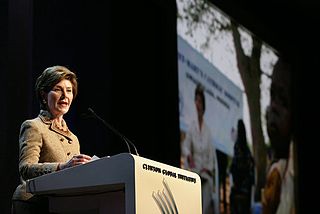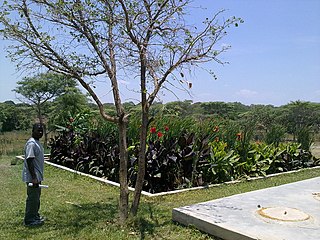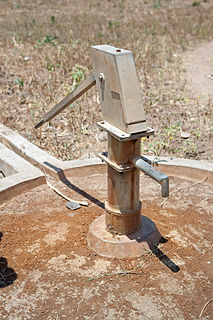A millwright is a high-precision craftsman or skilled tradesperson who installs, dismantles, repairs, reassembles, and moves machinery in factories, power plants, and construction sites.

A water supply system or water supply network is a system of engineered hydrologic and hydraulic components which provide water supply. A water supply system typically includes:
- A drainage basin.
- A raw water collection point where the water accumulates, such as a lake, a river, or groundwater from an underground aquifer. Raw water may be transferred using uncovered ground-level aqueducts, covered tunnels or underground water pipes to water purification facilities.
- Water purification facilities. Treated water is transferred using water pipes.
- Water storage facilities such as reservoirs, water tanks, or water towers. Smaller water systems may store the water in cisterns or pressure vessels. Tall buildings may also need to store water locally in pressure vessels in order for the water to reach the upper floors.
- Additional water pressurizing components such as pumping stations may need to be situated at the outlet of underground or above ground reservoirs or cisterns.
- A pipe network for distribution of water to the consumers and other usage points.
- Connections to the sewers are generally found downstream of the water consumers, but the sewer system is considered to be a separate system, rather than part of the water supply system.

Hand pumps are manually operated pumps; they use human power and mechanical advantage to move fluids or air from one place to another. They are widely used in every country in the world for a variety of industrial, marine, irrigation and leisure activities. There are many different types of hand pump available, mainly operating on a piston, diaphragm or rotary vane principle with a check valve on the entry and exit ports to the chamber operating in opposing directions. Most hand pumps are either piston pumps or plunger pumps, and are positive displacement.

The Roundabout PlayPump is a system that uses the energy created by children playing to operate a water pump. It is manufactured by the South African company Roundabout Outdoor. It operates in a similar way to a windmill-driven water pump.

An automobile repair shop is an establishment where automobiles are repaired by auto mechanics and technicians.
This article has been written in 2007 with partial updates since then, including most recently concerning access in 2012. Please feel free to update it further. The Spanish article includes some more up-to-date information.

The developing nations of Africa are popular locations for the application of renewable energy technology. Currently, many nations already have small-scale solar, wind, and geothermal devices in operation providing energy to urban and rural populations. These types of energy production are especially useful in remote locations because of the excessive cost of transporting electricity from large-scale power plants. The applications of renewable energy technology has the potential to alleviate many of the problems that face Africans every day, especially if done in a sustainable manner that prioritizes human rights.

Rapid improvements are being made in augmenting drinking water supply and sanitation in India, due to concerted efforts by the various levels of government and communities at improving coverage. The level of investment in water and sanitation, albeit low by international standards, has increased in size during the 2000s. For example, in 1980 rural sanitation coverage was estimated at 1% and reached 95% in 2018. Also, the share of Indians with access to improved sources of water has increased significantly from 72% in 1990 to 88% in 2008. At the same time, local government institutions in charge of operating and maintaining the infrastructure are seen as weak and lack the financial resources to carry out their functions. In addition, only two Indian cities have continuous water supply and according to an estimate from 2018 about 8% of Indians still lack access to improved sanitation facilities. A study by Water Aid estimated as many as 10 million Indians, or 5 percent of Indians living in urban areas, live without adequate sanitation. India comes in first place globally for having the greatest number of urban-dwelling inhabitants living without sanitation. India tops the urban sanitation crisis, has the largest amount of urban dwellers without sanitation, and the most open defecators(urban) with over 5 million people.

Access to water supply and sanitation in Ethiopia is amongst the lowest in Sub-Saharan Africa and the entire world. While access has increased substantially with funding from foreign aid, much still remains to be done to achieve the Millennium Development Goal of halving the share of people without access to water and sanitation by 2015, to improve sustainability and to improve service quality.

iDE, formerly International Development Enterprises, is an international nonprofit organization that promotes a business approach to increasing income and creating livelihood opportunities for poor rural households. iDE was founded in 1982 by Paul Polak, a Denver, Colorado psychiatrist who promoted the concept of helping poor people become entrepreneurs instead of simply giving them handouts. Originally, iDE was devoted to the manufacture, marketing, and distribution of affordable, scalable micro-irrigation and low-cost water recovery systems throughout the developing world. iDE facilitates local manufacture and distribution of these products through local supply chains that sell to farmers at an affordable price which they can repay in one growing season. This strategy allows farmers to grow higher value and surplus crops, and in turn links them to high-value crop markets where they can realize profits from their higher yields. Recently, their success is in the promotion of sanitation products to decrease the practice of open defecation leading to diarrheal disease.

Lift irrigation is a method of irrigation in which water is not transported by natural flow, but is lifted with pumps or surge pools etc.

Water supply and sanitation in Senegal is characterized by a relatively high level of access compared to the average of Sub-Saharan Africa. One of the interesting features is a public-private partnership (PPP) that has been operating in Senegal since 1996, with Senegalaise des Eaux (SDE), a subsidiary of Saur International, as the private partner. It does not own the water system but manages it on a 10-year lease contract with the Senegalese government. Between 1996 and 2014, water sales doubled to 131 million cubic meters per year and the number of household connections increased by 165% to more than 638,000. According to the World Bank, "the Senegal case is regarded as a model of public-private partnership in sub-Saharan Africa". Another interesting feature is the existence of a national sanitation company in charge of sewerage, wastewater treatment and stormwater drainage, which has been modeled on the example of the national sanitation company of Tunisia and is unique in Sub-Saharan Africa.
The Rural Agency for Sustainable Development (RASD) is an NGO based in the Ugandan town of Nkokonjeru. It was first established as a CBO in 2000 before gaining NGO status in 2005, serving communities in the wider Buikwe, Kayunga and Mukono District around Nkokonjeru. RASD has received broad support from the community through private donations and volunteer efforts as well as from the local government of the Nkokonjeru Town Council and Mayor. Engineers Without Borders groups from the University of California,Davis and Duke University have assisted RASD with new technology implementation. EWB-UK have recently started sending students on 3 month placements to help with ongoing RASD projects.

Pump Aid is an international non-profit organisation that was set up in 1998. It is headquartered in London and delivers all its services in Africa, mostly in Malawi. Pump Aid is a WASH NGO and is part of a worldwide programme committed to the delivery of the UN’s Sustainable Development Goals and the total eradication of water poverty by 2030. But, Pump Aid’s ultimate goal is to transform the lives and life chances of poor and disadvantaged communities, so that they reach a point of resilience and self-reliance where they no longer need the support of NGOs or anyone else.

Water supply and sanitation in Tanzania is characterised by: decreasing access to at least basic water sources in the 2000s, steady access to some form of sanitation, intermittent water supply and generally low quality of service. Many utilities are barely able to cover their operation and maintenance costs through revenues due to low tariffs and poor efficiency. There are significant regional differences and the best performing utilities are Arusha and Tanga.
The bush pump, also known as the Zimbabwe bush pump, is a positive displacement pump based on lever action used to extract water from a bore hole well. It is the standard hand pump in Zimbabwe, and is used in Zimbabwe and Namibia. There are approximately 40 000 pumps (2009) in Zimbabwe, and annually about 3000 pumps are installed.

Failures of water supply and sanitation systems describe situations where water supply and sanitation systems have been put in place (for example by the government or by non-government organizations but have failed to meet the expected outcomes. Often this is due to poor planning, insufficient stakeholder involvement at the various stages of the project and lack of maintenance. While Hygiene Behavior Change is important in achieving the health benefits of improved WASH systems, the achievement of sustainability of WASH infrastructure depends on creation of demand for sanitation services.

Decentralized wastewater systems convey, treat and dispose or reuse wastewater from small communities, buildings and dwellings in remote areas, individual public or private properties. Wastewater flow is generated when appropriate water supply is available within the buildings or close to them.















